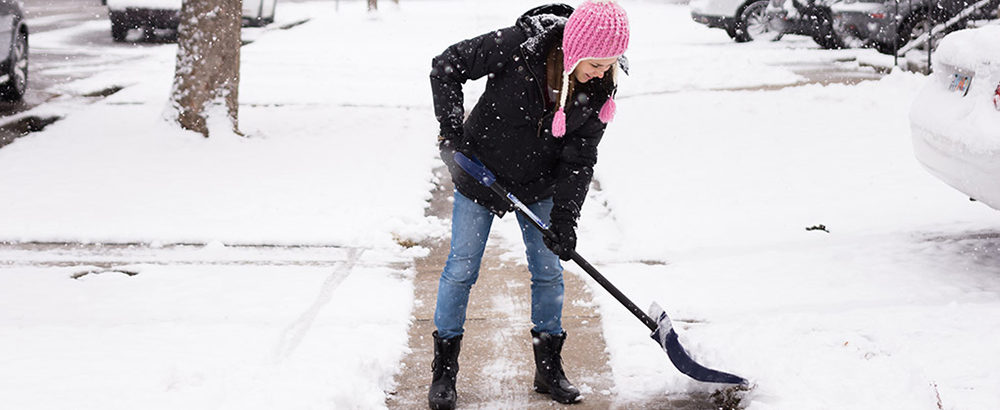By Permanente Medical Staff
Winter chores can be a healthy and satisfying way to spend time outdoors. But without proper precautions, storm clean-up and other outside maintenance can also be hazardous to your health.
Most people know that snow removal – whether it’s with a shovel or a snow blower – is hard on your heart. It’s been estimated that 100 people, mostly men, die every year in the United States from heart attacks suffered during or just after shoveling snow.
There is the unaccustomed exertion. Plus, cold weather can constrict blood vessels, increase blood pressure, and make blood more likely to form clots.
Also, more than 150,000 people are treated annually in emergency rooms for injuries suffered while removing snow, including strains and sprains, lacerations, and even finger amputations. So as you gear up for the winter months ahead, keep in mind these safety tips from the American Heart Association and the American Academy of Orthopaedic Surgeons.
Snow Shoveling: Lift Properly
Shoveling is incredibly strenuous. One Michigan researcher found that when healthy young men shoveled snow, their heart rate and blood pressure increased more than when they exercised on a treadmill. So if you are middle-aged or older, sedentary, or have any chronic health problems, check with your doctor before doing any snow removal. And consider asking a neighbor for help or hiring someone to do the work for you.
If you do choose to shovel, warm up the way you would before any strenuous exercise, with a little light jogging and stretching, especially of the lower back. Use a small, light shovel and try to push the snow rather than lift it. If you are lifting, lift small amounts of snow and use your legs, rather than your back. You should bend at the knees, never at the waist. Keep the shovel close to your body since lifting it away from you can multiply the force on your lower back many times. And you should avoid twisting motions like throwing snow over your shoulder or to the side.
It’s important to take frequent breaks and stay well-hydrated. Also be sure not to shovel too soon after drinking alcohol or eating a big meal, or to eat too soon after you shovel, because it puts an extra load on the heart. And do carry your cellphone; call 911 if your chest starts hurting, you feel dizzy or short of breath, your heart starts racing, or any other physical changes make you nervous.
Snow Blowing: Read the Manual
Because it’s easier than shoveling, most people don’t realize that pushing a snow blower around can also raise your heart rate and blood pressure. Thus, many of the shoveling precautions – including warming up and taking frequent breaks – apply here as well.
But, as with operating any power tool, there are additional safety precautions. Read the manual for your machine and use it properly. If you are using an electric snow blower, be aware of the power cord at all times. If it’s gas powered, always fill it with fuel before you start. Never add fuel while it is running or the engine is hot.
You should always wear hearing and eye protection when operating a snow blower. If it jams, always turn it off and use a solid object like a piece of wood – never your hands – to clear it of snow or debris. Don’t wear dangling scarves that can get caught in the machine, and be sure your hat and scarf are not impeding your ability to see.
Never let children operate snow blowers. Your kids and pets should be at a safe distance, preferably indoors, when your snow blower is in use.
De-icing: Check the Label
Small children and many pets like to eat and roll around in the snow. If you are de-icing your sidewalks and driveway, look for products labeled safe to use around them. Some products irritate paws, cause burns if they soak through mittens and other clothing, and may be toxic if ingested. And you should wear protective clothing – gloves, boots, and goggles – when applying them.
Ladder Use: Get the Right Angle
Perhaps the most dangerous of all home and yard maintenance operations is climbing a ladder – to clean your gutters, sweep snow or ice off your roof, decorate for the holidays, or even to prune a tree. The Centers for Disease Control and Prevention (CDC) estimates that a half million people suffer ladder-related injuries every year, and more than 300 people die from these injuries.
The CDC now offers a free app that addresses the leading causes of ladder falls and offers you all the tools and information you need to prevent them.
There are many ladder safety tips, but one of the most important is to be sure you always set your ladder on a very firm and level surface and set it at a proper angle. You should either set it at 75 degrees or follow the 1 in 4 rule: For every four feet of height you have to climb, move the base one foot from the wall. (The CDC app has a tool to help you set your ladder angle.)
You should never stand on one of the top three rungs, and should use a utility belt to hold tools so you are not reaching for them. In fact, it is recommended that you always move your ladder rather than reaching out to the side. One way to keep yourself from leaning too far is to always be sure that your belly button stays inside the sides of the ladder.
You should also wear sturdy, nonskid shoes or boots and be sure there is no oil on any of the ladder rungs. If possible, have a buddy spot you and/or stand on the lowest rung for ballast.
It’s more fun – and a lot safer – to have company when doing outdoor winter chores. If that’s not possible, carrying a cell phone in your pocket is the next best thing, so that you can call for help if needed.
For more information about health and safety, visit MAPMG on Health.




